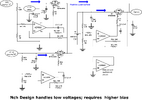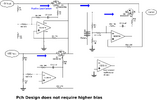Karklebapper
New Member
This is a couple of circuits which I devised maybe 16 years ago. The Pch design (without a higher bias) does require a rail-rail input op amp. But the Nch design with higher bias can use a general purpose op amp such as LM324. These circuits will select the highest of the available inputs, even when the voltage differentials are small, such as 20 mV for example.
Using op amps like this, the circuits are slow so will require at least many microseconds to react.
With low Vos op amps and adequately sized FETs this circuit can work well with voltage drops (and input differentials) in the low mV for example.
It has been many years, but I built and tested these circuits pretty much as shown many years ago. I might have a board somewhere...
Using op amps like this, the circuits are slow so will require at least many microseconds to react.
With low Vos op amps and adequately sized FETs this circuit can work well with voltage drops (and input differentials) in the low mV for example.
It has been many years, but I built and tested these circuits pretty much as shown many years ago. I might have a board somewhere...



